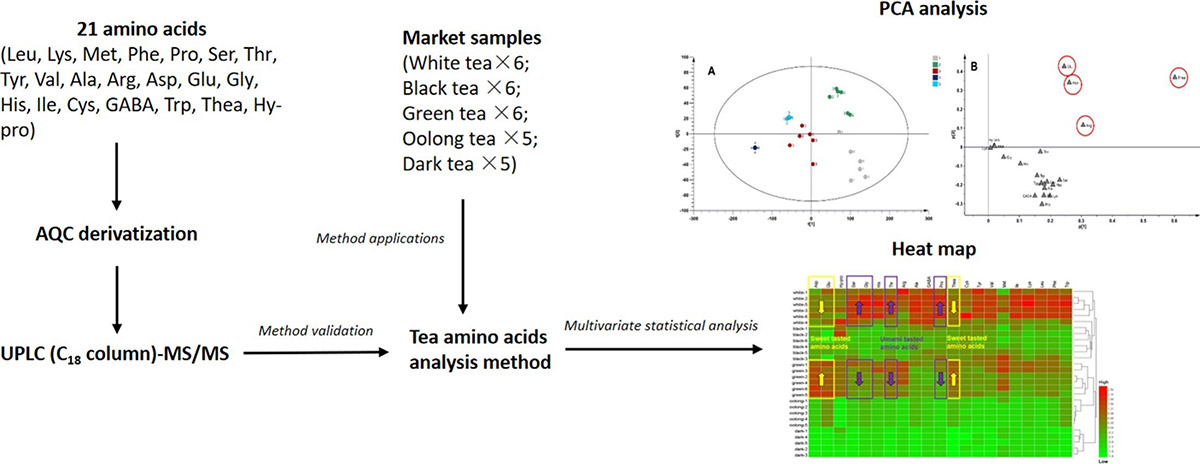Amino acids are organic compounds with amino and carboxyl groups in tea leaves and are one of the leading chemical components in tea. Among them, there are more than 20 kinds of amino acids which affect the taste, aroma, and color of tea leaves. Among them, free amino acids such as theanine, glutamine, and glutamic acid give tea its unique fresh flavor and give it a savory and refreshing taste. Tryptophan and phenylalanine, on the other hand, contribute to the intensity of bitterness and astringency of tea. In addition, theanine, a unique free amino acid in tea, has a protective effect against neurological diseases. Histidine and leucine act as antioxidants and branched-chain amino acid balance, respectively. In conclusion, free amino acids are essential for improving the quality and health benefits of tea.
 Fig.1. Determination of 21 free amino acids in 5 types of tea by ultra-high performance liquid chromatography coupled with tandem mass spectrometry (UHPLC-MS/MS). (Zhou P et al, 2019)
Fig.1. Determination of 21 free amino acids in 5 types of tea by ultra-high performance liquid chromatography coupled with tandem mass spectrometry (UHPLC-MS/MS). (Zhou P et al, 2019)

The composition and content of tea free amino acids, as well as their degradation and transformation products, directly affect tea quality. Due to their essential role in the chemical composition of tea, they have received much attention over the years. National standards have been established to test the total amount of free amino acids in tea.
As a recognized leader in tea testing, Lifeasible can help you develop the best solution for rapid and non-destructive detection of total free amino acids in tea. Our laboratories have established clear and straightforward methods for the detection of free amino acids in tea, including:
We can detect a wide range of free amino acids in a variety of teas, such as green tea, black tea, white tea, and black tea, including but not limited to:
| Neutral Amino Acids | Glycine, alanine, leucine, isoleucine, hemidine, serine, methionine, phenylalanine, tryptophan, etc. These amino acids have an important role in the harmonization of tea taste. |
| Acidic Amino Acids | Glutamic acid and aspartic acid. They are the most important class of amino acids in tea, with high content in tea leaves, and are important components in constituting the fresh taste of tea. |
| Alkaline Amino Acids | Arginine and lysine. |
| Theanine | This is the characteristic free amino acid in tea, which has a fresh taste and plays an important role in the formation of the aroma of tea leaves and the color of the soup. |
We provide accurate, simple, and sensitive methods for directly determining free amino acids in tea. Both TOF-MS and IDA-MS/MS detection can be achieved with a single injection and accurate mass numbers, isotopic distribution, and secondary ion fragmentation information can be obtained. Our tea total free amino acid testing service is widely used for the rapid determination of free amino acids in tea. It provides a reference for determining amino acids in other plant tissues. We aim to provide technical support for tea quality analysis and research. If you are interested in our solutions, please contact us for technical consultation and quotation.
Reference
Lifeasible has established a one-stop service platform for plants. In addition to obtaining customized solutions for plant genetic engineering, customers can also conduct follow-up analysis and research on plants through our analysis platform. The analytical services we provide include but are not limited to the following:
STU-CRISPR System Improves Plant Genome Editing Efficiency
April 19, 2024
Application of Exosomes in Facial Beauty
April 12, 2024